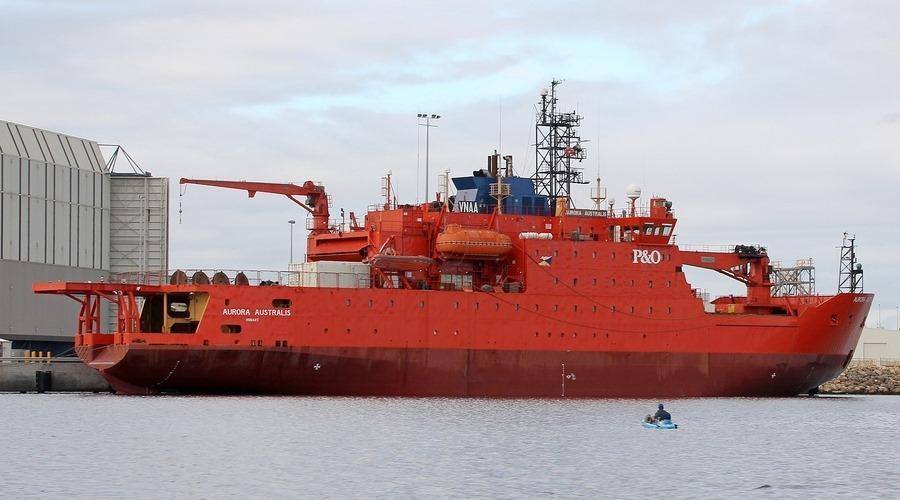Aurora Australis icebreaker
Aurora Australis icebreaker current position
The current location of Aurora Australis icebreaker is in South East Asia (coordinates 10.40466 N / 107.10515 E) cruising en route to AE DXB > VN VUT. The AIS position was last reported 3 minutes ago.
Current PositionSpecifications of Aurora Australis icebreaker
| Year of build | 1990 / Age: 35 |
| Flag state | Marshall Islands |
| Builder | Carrington Slipways (New South Wales, Australia) |
| Class | Australian diesel icebreaker |
| Speed | 16 kn / 30 km/h / 18 mph |
| Length (LOA) | 95 m / 312 ft |
| Beam (width) | 20 m / 66 ft |
| Gross Tonnage | 6574 gt |
| Passengers | 116 |
| Crew | 24 |
| Decks | 5 |
| Owner | P&O Maritime Services |
| Operator | DMS Maritime (Defence Maritime Services) Australia |
Aurora Australis icebreaker Review
Review of Aurora Australis icebreaker
RSV Aurora Australis is an icebreaking vessel owned by P&O Maritime Services and operated by P&O Polar. Since 2006, P&O Maritime has been owned by DP World—a Dubai-based maritime company that also owns ports and marine terminals. Another well-known DP World brand is P&O Ferries, a British passenger shipping line. In 2020, Aurora Australis was replaced by the newbuild icebreaker RSV Nuyina.
The vessel (IMO number 8717283) is Marshall Islands/France-flagged (MMSI 538009024) and registered in Majuro.

P&O Aurora Australis' itinerary program includes Antarctic cruise expeditions. The icebreaker is often chartered by the AAD (Australian Antarctic Division) to support Australian research bases and conduct scientific operations.
History and Ownership
One of the Australian Antarctic icebreakers, Aurora Australis is a multi-purpose resupply and research vessel designed for polar operations.
In 1998, the vessel became stranded in ice. A towing attempt was made by the Japanese icebreaker Shirase, but the engineering crew aboard Aurora Australis managed to carry out temporary repairs, allowing her to resume sailing under her own power.
In May 2011, the ship was chartered for two months by the Australian Government (Department of Defence) to support the Royal Australian Navy. The charter cost was AUD 3.375 million.
In December 2013, the icebreakers Xue Long (China), L'Astrolabe (France), and Aurora Australis attempted to rescue the stranded Russian research vessel Akademik Shokalskiy, which was trapped in Antarctic glacial ice. The three ships were unable to reach the vessel and turned back. The crew of the Shokalskiy prepared a helipad on the surrounding ice for evacuation, which took place on January 2, 2014, using helicopters from Xue Long. Meanwhile, Xue Long also became trapped in Commonwealth Bay (~1700 mi / 2740 km south of Tasmania). The ship was later rescued by USCGC Polar Star, a US Coast Guard heavy icebreaker.
On February 24, 2016, during resupply operations in Horseshoe Harbour (Antarctica), Aurora Australis broke free from her moorings due to a blizzard and ran aground. At the time, there were 67 crew members onboard and no cruise passengers.
Aurora Australis Vessel Details and Technology
The vessel is equipped with laboratories for meteorological, oceanographic, and biological research. It also features an aft trawl deck for deploying and retrieving research instruments. A hangar and helideck support operations with up to four helicopters.

Facilities include one dining room, a sauna, one helipad, but no swimming pool or elevators.
- Max Draft: 8 m (26 ft)
- Displacement: 8158 tons
- Deadweight: 6574 tons
- Icebreaking capability: 1 m (3 ft)
- Cargo capacity: 29 TEUs (containers), 1700 m³ bulk cargo, 1000 m³ supply fuel, 4 helicopters
- Powerplant: Wartsila 16V32D diesel engine (5.5 MW output), Wartsila 12V32D (4.5 MW output)
- Propulsion: 1 controllable-pitch propeller with nozzle; 3 thrusters (1 bow, 2 stern)
Note: In areas with limited AIS coverage, real-time tracking of the vessel may not be possible. Visit CruiseMapper’s Icebreakers hub to view all icebreaking and research vessels, along with their itineraries and operating states.

